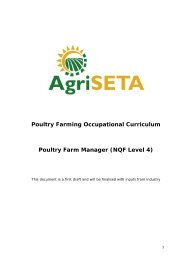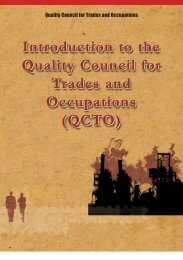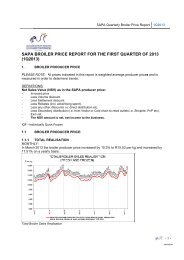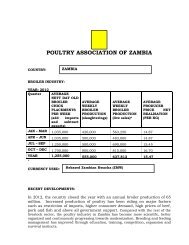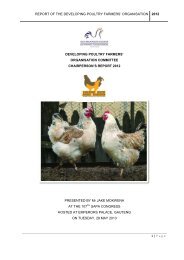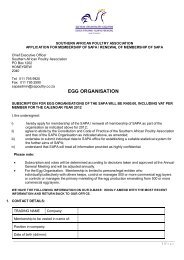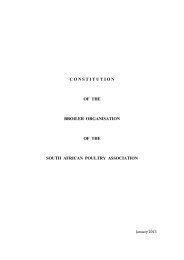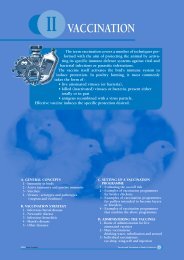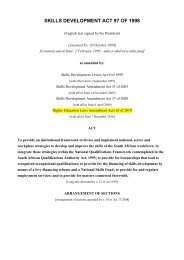industry news - SAPA
industry news - SAPA
industry news - SAPA
You also want an ePaper? Increase the reach of your titles
YUMPU automatically turns print PDFs into web optimized ePapers that Google loves.
INTERNATIONAL NEWS<br />
Any chicken company which is currently unhedged on grain in<br />
the US is losing a substantial amount of money very quickly.<br />
Anecdotal information suggests that many small and medium<br />
sized companies are unhedged. The largest firms tend to be<br />
hedged. As a result there will be a considerable amount of<br />
financial stress on small US companies this year. In the rest of<br />
the world, results vary by country but the overall situation is one<br />
of stressful grain prices causing financial difficulties for chicken<br />
companies. However, the <strong>news</strong> is not all bad. The good <strong>news</strong> is<br />
that prices of competing meats are high around the world and<br />
are expected to go even higher. In the US, beef prices are up<br />
20% and pork is up 30% from levels a year ago. These higher<br />
prices will help to pull chicken closer to profitable levels. In<br />
addition, due to the poor feed conversion of (feedlot) beef and<br />
pork, prices of those competing meats will trend upward at a<br />
faster rate than chicken in the next 12 months. These higher<br />
prices for competing meat should help increase the price of<br />
chicken to profitable levels. However, in some countries like the<br />
US, a temporary cutback in chicken production may be required<br />
to return the <strong>industry</strong> to profitability.<br />
This month the government of Mexico started an investigation<br />
into claims that the US was dumping leg quarters into Mexico.<br />
Mexico was the largest market for US leg quarter last year when<br />
Russia banned US imports for 10 months and then cut import<br />
quotas by half. China is still severely restricting chicken<br />
exported by the US. Russia, Mexico and China represented the<br />
three largest markets for US leg quarters. Leg quarter prices<br />
started 2011 at the same level as last year. However, last year<br />
at this time, exports to Russia had halted completely. This year,<br />
exports are flowing to Russia (although at a slower pace than in<br />
earlier years). With at least some product flowing to Russia,<br />
Mexico still open for the moment, and world demand in general<br />
improving, leg quarter prices should be higher than last year. In<br />
addition, at some point during the year, production cut-backs in<br />
the US will restrict the supply of leg quarters leading to even<br />
higher prices. The high price of competing meats also helps.<br />
Leg quarter prices should end the year at 45 cents per pound<br />
($1 per kilo) versus 35 cents ($0.77 per kilo) last year.<br />
Increased chicken production late last year in the US brought<br />
DBB prices down to highly unprofitable levels. Nevertheless, in<br />
the spring, seasonal demand will increase and supply will<br />
inevitably moderate leading to higher prices. DBB prices<br />
bottomed out at $1.10 ($2.40 per kilo) and will rise with<br />
production cutbacks as well as the high price of competing<br />
meats. It would not be surprising to see DBB at nearly $2 per<br />
pound later in the year ($4.40 per kilo).<br />
45 | MARCH 2011 PLUIMVEE POULTRY BULLETIN<br />
In 2010, the world chicken <strong>industry</strong> grew by 3.3%. With the<br />
spike in grain prices, the 2011 increase may slow to 2.2%. By<br />
2012, grain prices could be falling, the world economy will be<br />
picking up steam and it could be a time of increasingly profitable<br />
chicken production. The last several years have been marked by<br />
erratic growth to say the least but the trend is up from 2009.<br />
In 2010 the US chicken <strong>industry</strong> increased production at a rate<br />
of 4%. In 2011, production increases will slow with the<br />
headwinds of the perfect grain storm. However, thanks to the<br />
good feed conversion of chicken and high competing meat<br />
prices, the overall trend line of chicken production increases<br />
from 2008 to 2012 with two notable dips in 2009 and 2011.<br />
US red meat production has been dropping since 2008 partly<br />
due to the recession and partly due to high grain prices. Due to<br />
the importance of feed conversion, persistent high grain prices<br />
will force red meat production to fall despite relatively high meat<br />
prices and the upturn in the economy.<br />
Paul Aho Ph.D is an international agribusiness economist<br />
specialising in projects related to the poultry <strong>industry</strong> and has<br />
been a prolific writer in trade journals in both the United States<br />
and in Latin America. Dr. Aho now operates his own consulting<br />
company called “Poultry Perspective”. In this role he works<br />
around the world with poultry managers and government policy<br />
makers. E-mail: PaulAho@PaulAho.com.This article is an edited<br />
extract from the February issue of Aviagen's Broiler Economics,<br />
kindly supplied by Stanley Millar, Commercial Manager of Arbor<br />
Acres - Middle East and Africa.



